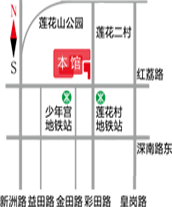
- THE FUNDAMENTAL——THE LITERATI PAINTING OF CHEN LYUSHENG
-

Click to view Exhibition Dates: June 7th - June 18th, 2017
Opening Ceremony: 4:30 PM, June 7th, 2017
Venue: Central Hall and Hall C, 1st Floor, Guan Shanyue Art Museum, Shenzhen
Organizers: Guan Shanyue Art Museum, Shenzhen & Chen Lyusheng Art Museum
On June 7th, 2017, "THE FUNDAMENTAL——THE LITERATI PAINTING OF CHEN Lyusheng" opened at the Guan Shanyue Art Museum in Shenzhen, showcasing 75 paintings created by Mr. Chen Lyusheng in recent years. Notably, the series of paintings titled "Literary Thoughts" featuring the Chinese Scholar Tree (also known as the Goldenrain Tree) is exhibited for the first time in Shenzhen.
As a scholar, Chen Lyusheng has dedicated himself to the research of art history and criticism, making groundbreaking contributions in the fields of modern Chinese art history, Han dynasty art studies, and art editing. He has authored columns in prestigious publications such as "Wenyi Bao" (Literary News) and "CHINA ART WEEKLY" . As a painter, Chen Lyusheng is renowned for his unique brushwork and cultural depth embodied in his works. His landscapes, characterized by minimalist peaks, rocks, clouds, and streams, convey both the traditional spirit and modernity of landscape painting aesthetics. His plum blossoms, deviating from ancient conventions, showcase a straight and upright trunk, devoid of the slanting branches and gnarled trunks traditionally sought after, demonstrating rigor and elaboration amidst myriad variations, imbued with a thought-provoking modernity. His compositions are peculiarly structured and meticulously planned; he incorporates calligraphy into painting, emphasizing mood, interest, and charm. Skilled in inscriptions, he complements his paintings with inscriptions that become integral parts of the artwork, addressing any deficiencies in the visual narrative.
Through Chen Lyusheng's brushstrokes, the tenacious vitality and independent spirit of ancient trees, exemplified by the Chinese Scholar Tree, are interpreted in ink and wash, embodying the scholarly character akin to that of the plum, orchid, bamboo, and chrysanthemum, extending the contemporary spirit of scholarly integrity. It can be said that the development of his own style is a defining feature of Chen Lyusheng's painting. The Chinese Scholar Tree, a subject rarely depicted in traditional Chinese ink painting, is uniquely represented by Chen. In traditional landscapes, trees are often rendered through textured brushstrokes, serving as accents that complement the overall mood of the painting. Chen, however, directly focuses on the trees themselves, using intricate linework to express the character of their vitality and decay, a creative approach that defines the "Chen Style."
The exhibition is structured into four sections: "Scholars," "Literary Mind," "Literary Thoughts," and "Literary Brilliance." "Scholars" showcases Chen's plum blossoms, bamboo, and narcissus series, exploring the core values of traditional Chinese ink painting through scholarly themes. "Literary Mind" presents his landscape series, including the monumental "Sitting Facing the Cold River," showcasing the typical style and aesthetic preferences of Chen's landscapes. "Literary Brilliance" includes his spring jasmine, wintersweet, and other series, reflecting Chen's unique interpretation of these subjects and his exploratory expressions, exemplified by the vibrant "Eighteen Jasmine Trees Responding to the Warmth of Shao Yang" in a monumental format. "Literary Thoughts" features Chen's winter tree series, centered on the theme "Flourish as it may, Wither as it may," which, more than a celebration of winter trees, represents a comprehensive observation of the environment, society, and humanity inspired by the trees lining Beijing's streets.
Over the years, Chen Lyusheng has meticulously observed and photographed numerous trees with resilient postures during his daily commute. He once expressed, "My focus on painting the Chinese Scholar Tree stems from its noble character, akin to that of the plum, orchid, bamboo, and chrysanthemum, yet distinct in its demeanor and posture. It possesses neither fragrance nor beauty, yet remains modest and unassuming, adapting to its surroundings with ease."
Regarding the exhibition theme "THE FUNDAMENTAL", it is derived from Confucius' "The Analects of Confucius": "The gentleman pursues fundamentals, and when fundamentals are established, Tao appears." The reason why Chen Lyusheng's painting exhibitions have consistently taken "THE FUNDAMENTAL" as their theme is that Chen Lyusheng has always taken this as his motto. Like many literati painters throughout history, he balances between work, navigating the professional world and academia, and leisurely indulging in calligraphy and painting, finding spiritual solace and expression therein. Chen Lyusheng believes that "the fundamental" is the source of "Tao"; without "the fundamental," "Tao" is lost. It can be said that every industry faces the issue of "pursuing fundamentals," and calligraphy and painting are no exception. However, in today's world, "pursuing fundamentals" has become a difficult endeavor because "the fundamental" itself has undergone changes, becoming vague and less defined than before. Many aspects of the essence of Chinese ink painting have been repeatedly transformed by new cultures, moving increasingly towards modernization. Thus, this "fundamental" exists only conceptually and macroscopically, intertwined with traditional culture. Today's "pursuit of fundamentals" is not merely the inheritance of an existing, ready-made "fundamental" but rather the primary task of researching and exploring what "the fundamental" truly is and where it lies. "The road ahead is long and winding," and Chen Lyusheng is precisely one who perseveres on this path of earnest exploration.
The exhibition will run until June 18th.
-
2017-06-05



